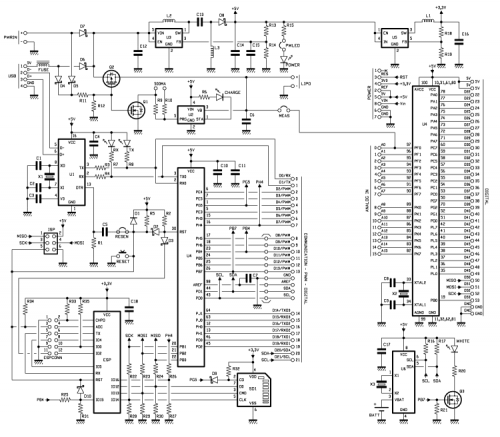
[tps_header][/tps_header]
The Fishino version of the powerful and popular board, Arduino MEGA: a revised hardware with a different power section.
In this article we will present Fishino MEGA. It is a board that is compatible with Arduino Mega. In its hardware we implemented a significant innovation: the possibility to have it battery powered.
As a first thing, let’s see Fishino MEGA’s complete features:
- it is 100% compatible with Arduino MEGA;
- it has a WiFi module on board, and is fully provided of libraries we developed;
- it has a microSD reader on board;
- it has a RTC module on board;
- it has an integral switching power source, capable of supplying about 800 mA-1A (for a total between 3 and 5 volts), starting from an input voltage that may vary between 3 and 20 volts;
- it has a single cell LiPo battery connector and a battery charger on board;
- it has an additional side connector, in order to solve the well known misalignment bug found in the Arduino series, that makes it impossible to use it along with stripboards and breadboards.
Circuit diagram
The “highlight” of this new board is the power source section, that required a long development time and that also brought to the creation of a distinct multi-usage power supply. For a detailed description of the SEPIC converter that has been used, please refer to the said article, while here we will limit ourselves to making a brief description and to analyzing the surrounding circuitry in detail.
Let’s start from the power supply inputs, that bring three voltages:
- VLiPo, that refers to the lythium polymer (LiPo) rechargeable battery’s connector;
- VUSB, that refers to the microUSB connector;
- VIN, that refers to the PWRIN power supply’s plug.
The two voltages that are usually higher, that is to say VUSB and VIN (in truth we may apply a lesser voltage to the PWRIN connector, and up to 3.2 volts, even though it is inadvisable since it implicates a loss in efficiency), pass through the two Schottky power diodes, D6 and D7, while the “lower” voltage, for efficiency reasons, is directed towards the MOSFET having a P channel signed as Q2.
Let’s omit the Q2 functioning for a second (we will shortly return on the subject), and consider only the diode that is internal to it; the three diodes (D6, D7 and the diode that is internal to the MOSFET) create an OR power port, that enables to obtain the greatest voltage among the ones found at the inputs; let us suppose, for example, to have only the VLiPo voltage, of about 3.7V: in this case the diode that is internal to the MOSFET will turn out to be directly polarized, by bringing the same voltage towards the converter, and that it cannot return towards the other two inputs, because of the presence of the D6 and D7 diodes that are inversely polarized.
Now, if we connect the microUSB connector, the VUSB voltage (5 volts) will directly polarize the D6 diode and reach the converter, while the diode that is internal to the MOSFET is found with a voltage of 4 volts at the anode and a 5 volts one at the cathode: therefore it turns out to be inversely polarized, interdicting itself.
If, finally, we also power the PWRIN input with a voltage that is greater than 5 volts – for example 15 volts – the D7 diode will turn out to be directly polarized, thus bringing the VIN voltage to the converter, while the D6 diodes and the one that is internal to the MOSFET will be inversely polarized, thus interdicting themselves.
We therefore reached the intended purpose, that is to say a totally automatic commutation of the power source.
Let’s return now to the MOSFET that is inserted on the LiPo connector’s positive line; apparently it is an unnecessary component, since its internal diode is enough to achieve the commutation; unfortunately the diodes (even the Schottky ones) have a voltage fall at their ends that – no matter how small – causes voltage losses that turn out to be significant with high currents.












